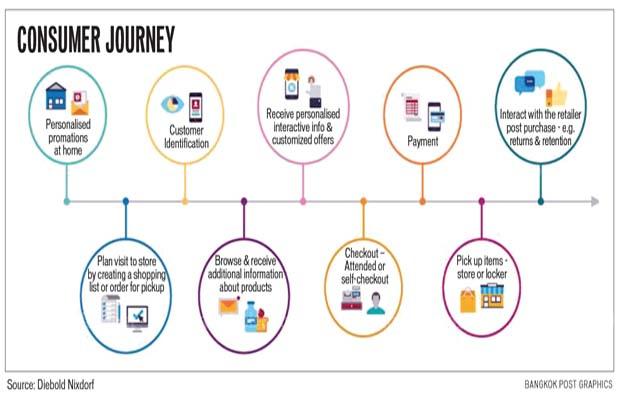Thailand – ‘Storevolution’: The new era of retail
The retail industry bases its success on giving consumers a choice — and malls and “big-box” stores have thrived based on this desire for “options”. As retailers introduce more options, consumers have responded by embracing the new, and yet keeping the old.
Today’s shoppers fully expect to move seamlessly between a store’s physical and digital channels while on their shopping journey, according to Diebold Nixdorf, a multinational provider of cash-handling hardware, software and services for the financial and industries. They crave an experience that is customised and individual.
Customers want to develop a consistent relationship with a brand regardless of channel. This makes the customer journey the central element in any retail overhaul.
Digital and omnichannel solutions have been revolutionising the retail industry, with modern bricks-and-mortar retailers facing market challenges that are forcing them to evolve. There is a fundamental shift from channel-centric to consumer-centric, and this approach will transform the entire retail landscape.
While retailers increasingly look for solutions to improve consumer shopping experiences, they need to adopt interactive technologies that keep them “always available” and efficient, ultimately providing a “store as a service” concept.
The Storevolution has begun: Amazon Go has made many traditional retailers uneasy, and for good reason. This new type of store, currently being tested by the online retail giant, aims to completely disrupt the physical shopping model by providing an experience with no lines and no checkout. Shoppers simply walk in, take the items they want and leave, with tracking of goods and payment automatically processed by the Amazon Go app.
With this move, Amazon validates the valuable role bricks-and-mortar stores will continue to play in the future of retail. However, it also denotes how dramatically these sites must change and innovate to remain relevant.
Diebold Nixdorf, which plays a major role in “connected commerce”, uses the term “Storevolution” to convey the two different approaches that retailers are using — evolution and revolution — depending on what they think needs to be done.
In an industry, region or context where it is difficult to predict the market or future sales, and to select the right strategies and technologies, Storevolution combines creation and prediction. It represents a programme that understands the key trends, defines the key enablers, and initiates the right strategic moves to help retailers build their vision of the future.
Customer journey as the centre of the retail universe: In the past, the customer journey was simple — a customer visited a store, located the desired articles and closed the transaction (assisted by staff).
Today, customer journeys are much more complex. There are numerous possibilities and most involve several different touchpoints. However, most can be placed into one of two main categories — short and long.
In a short customer journey, the consumer has a limited time frame in which to shop. She wants to buy a few predetermined articles, pack and pay as soon as possible. The primary objective is speed.
A long customer journey, on the other hand, is about facilitating the best possible shopping experience. In this journey, the consumer has more time but she demands more from the encounter. For example, she may expect to receive real-time coupons, recipes and more offers based on the items she’s scanned or placed in her cart.
She may expect specific promotions to be pushed to her smartphone or to receive in-store navigational assistance via the retailer’s mobile app. In a long journey, the customer expects a customised experience and instant benefits.
Whether the journey is short or long, retailers need to keep five points in mind in order to succeed:
1. In each journey, the customer has all the power.
2. To ensure an optimal shopping experience, the retailer must have in-depth knowledge of each customer’s specific profile.
3. The retailer should strive to have an “always-on” connection to the customer and initiate the journey outside of the store setting.
4. The retailer should recognise the customer as soon as she enters the store.
5. The retailer must ensure the journey continues after the customer leaves the store.
The convergence of physical and digital retail is a must for continued success, but getting there can be a challenge for retailers with a strong existing bricks-and-mortar presence.
The key is to shift your focus away from the channel and place it squarely on the customer journey and the overall consumer experience.
It is important to focus on the right things and discover how you can help the customer navigate and manage this unpredictable future with so many options. There are so many questions and even more answers. To make it simple, the key is to innovate shopping journeys and improve consumer experiences with the right solution for your business.
The second article of this two-part series will look at different dimensions that will intuitively create an opportunity for retailers to successfully connect all aspects of commerce.
Source: https://www.bangkokpost.com/business/news/1488194/storevolution-the-new-era-of-retail


 Thailand
Thailand




